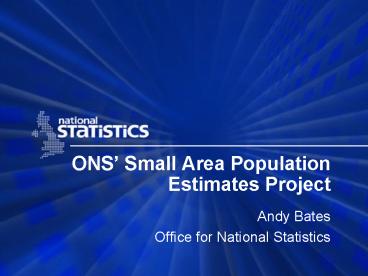ONS Small Area Population Estimates Project - PowerPoint PPT Presentation
1 / 34
Title:
ONS Small Area Population Estimates Project
Description:
led to setting up of Neighbourhood Statistics. requirement for small area population ... Key postcoded data sources. Patient registers - Health Authorities ... – PowerPoint PPT presentation
Number of Views:72
Avg rating:3.0/5.0
Title: ONS Small Area Population Estimates Project
1
ONS Small Area Population Estimates Project
- Andy Bates
- Office for National Statistics
2
Project background
- National Strategy for Neighbourhood Renewal
- led to setting up of Neighbourhood Statistics
- requirement for small area population estimates
- ONS Population Statistics Review September 1998
- found unmet user need for small area population
estimates
3
Purpose of the project
- To investigate the feasibility of producing
an authoritative set of small area population
estimates that would be available on a nationally
consistent basis (England and Wales) - which methods and data sources?
- what geography?
- what age/sex breakdown?
- how accurate?
- constrained to ONS LA mid-year estimates
4
Methods - key points
- Potential methods identified and short listed
- Averaging estimates may improve accuracy
- Constraining smaller estimates to larger ones may
improve accuracy - Method performance depends on data used and the
characteristics of an area
5
Short listed methods
- Apportionment
- Additive/ratio change
- Cohort component (ageing on element)
- Combination of above (hybrids)
6
Key postcoded data sources
- Patient registers - Health Authorities
- Births and deaths - Registrars
- Prisoners - Home Office
- Dwellings - Council Tax lists, Postcode Address
File
7
Key aggregated data sources
- Child benefit - formerly DWP, now Inland Revenue
- Retirement benefits - DWP
- Electorate - Electoral registers
- UK Armed Forces - Defence Analytical Services
Agency
8
Data sources - key points
- Need to consider data quality
- Datasets ideally need to be available nationally
and cover sub-populations - Potential for smoothing datasets over time
- Could borrow strength by combining different
datasets
9
Administrative data analysis
- Patient Registers (adjusted) 2.9m (5.5) above
the MYEs - Electorate (adjusted) 0.9m (2.0) below the MYEs
- Child Benefit (adjusted) 101,000 (1.0) below the
MYEs - Older persons 132,000 (1.6) below the MYEs
10
Patient Register comparison with MYEs
11
Patient Register comparison with MYEs
12
Evaluation criteria
- Acceptable
- Adaptable
- Data available
- Good quality estimates
- Robust
- Minimal burden on data suppliers
- Easy to explain/not too complex
- Takes account of population sub-groups
- Timely to produce
- Value for money
13
Evaluation stages
- Data comparison with 2001 derived ward MYEs
- Analyse data according to ward area type - ward
categorisation - Create test estimates using different data/method
combinations - Evaluate test estimates
14
Ward categorisation
- Purpose - to help evaluate administrative data
and estimates - How? By categorising wards according to a number
of characteristics eg - small population size
- high proportion of young adults in population
- student areas
- areas with high levels of in and out-migration
- inner urban areas..
15
Ward categorisation
Inner Urban (population density)
16
Ward categorisation
Full-time Students 19-22
17
Ward categorisation
Unemployment
18
Ward categorisation
Non-White Ethnic Groups
19
Ward categorisation
International in-migrants
20
Conclusion
- Research is ongoing
- Recommendation on suitable ward methodology
March/April 2004 - Investigation to be done for producing estimates
for other geographies
21
Small Area Estimation
- Jane Longhurst
- Office for National Statistics
22
Outline
- The small area problem
- ONS research and development
- Implementation of methods
- Dissemination of estimates
- Future work
23
Requirements for Small Area Information
- Assessment and allocation of resources
- Policy development and review
- Planning service provision
- General economic and social research
24
The Small Area Problem
- Surveys provide reliable national/regional
estimates - BUT For local areas the sample size is small or
zero - Administrative/census data is available for all
local areas - BUT information not generally appropriate
25
Model-based Estimation
- Model the relationship between survey data and
administrative/census data for the sampled areas - Use the model specification with
census/administrative data to produce estimates
for all areas
26
Research and Development
- ONS set up Small Area Estimation Project, SAEP
- To research and develop a generic methodology for
small area estimation from household based
surveys - Methodology developed to cater for clustered
design form of most UK household surveys - Research project established for estimating
unemployment levels and rates - Developed data framework
27
Implementation
- Unemployment
- Labour Force Survey, Claimant Count
- Income
- Family Resources Survey, Census and Admin data
sources - Crime
- British Crime Survey, Feasibility study
28
Map showing UA/LADs where LFS direct estimates of
ILO unemployment can be published.
29
ILO Unemployment
- We provide estimates of two measures of interest
- total ILO unemployed population
- ILO unemployment rate - proportion of
economically active population who are unemployed - 95 confidence intervals
- We provide estimates for
- period 95/96 to 99/00
- UAs and LADs for England, Wales and Scotland
30
Map showing modelled UA/LAD estimates of ILO
unemployment.
31
Income
- We provide estimates of
- average weekly household income
- gross and net - unequivalised
- net before and after housing costs - equivalised
- 95 confidence intervals
- We provide estimates for
- period 98/99
- wards for England, Wales and Scotland
32
Validation
- Internal validation
- External validation
- Methodological validation
- Validation with other data sources
- Validation with users
33
Dissemination
- Publication as experimental statistics
- Estimates, CIs and documentation
- Metadata
- User guidance
- Technical reports
34
Future Plans
- Update ILO estimates with re-weighted LFS data
- Produce income estimates for 01/02
- Extend work on BCS
- Develop methods for other variables for NeSS
- Ongoing research































